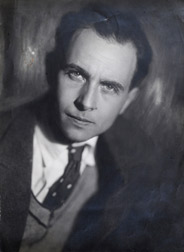The exhibition presents the paintings, drawings, collages and sculptures of over forty artists whom Aragon wrote about expressly: from Signac to Pirosmani, from Matisse to Picasso, including Marquet, Chagall, Klee and younger artists such as Titus-Carmel, Le Yaouanc, and Moninot, whom Aragon encouraged since their first exhibition. The works are illustrated by the writer’s most striking remarks, and accompanied by books and documents from their time. First it was Philippe Soupault’s turn to be consecrated in 1989 by the town of Montreuil, then André Breton’s in 1991 by the Centre Georges Pompidou. Today it is the turn of the third musketeer of Surrealism, Louis Aragon.
 Portrait of Aragon, Fonds Aragon-Moulins de Villeneuve collection. Ministry of Culture and Communication. Photograph non-identified – 1930s.
Louis Aragon (1897-1982), the founder of the Surrealist movement with André Breton and Philippe Soupault, is one of the most brilliant and most complex minds of the XXth century. The three men opened a dialogue very early with painting. The volume of this work is such that it represents a real corpus in its own right in their work. Aragon considered art and literature entwined, both questioning man and the world and, in doing so, verbal and pictorial languages as well. The poet believed that objects are words and words are building material. The encounter between the author and major painters was fundamental. «It always marked an important phase in my own view of things», he wrote.
The revolution of the collage
Through Guillaume Apollinaire and Pierre Reverdy he met these painters, some of which would accompany him all his career. Aragon, intimately linked to those he called «the adventurers of stone and canvas», was closely linked to the capital events of the history of art of the XXth century. He published as of 1923 a text on Max Ernst, then in 1930, as a preface to an exhibition, La Peinture au défi (The challenge of painting), thoughts on collages, inspired by the artist’s La Femme 100 tête, as well as by works by a great number of Dadaist and Surrealist artists he was still linked to: Duchamp, Picabia, Arp, Man Ray, Miró, Tanguy… In this fundamental text that foreshadows what contemporary creation would become, Aragon draws up the history of this new art, tries to explain «the challenge the collage represents to traditional painting» and wonders about Realism, be it socialist Realism.
 Niko Pirosmani the oxen and the peasant
He went deeper into these concepts in 1935 in his work Pour un réalisme socialiste (In favor of a Socialist Realism). As of that moment, he became the defender of artists such as Taslitzky, Fougeron (when he is not recriminating him for making the wrong choices), and Soviet artists. These articles did not prevent him from writing simultaneously articles on Pirosmani, Signac, Matisse, Picasso, Léger, Chagall, Miró, Ernst, Masson, Malkine, Hoffmeister, Giacometti, Grüber, Buffet, Kolar, Fassianos… for catalogues or newspapers, in particular for Les Lettres françaises, the literary weekly Aragon directed from 1953 to 1972, seconded by Pierre Daix, chief editor, and which would be published again in Aragon, Ecrits sur l’art moderne (1981). Lastly, in 1970, he dedicated a remarkable essay to his friend Matisse, whom he met thirty years earlier. Aside from his writings, Aragon was also a fine collector: he had works by Braque, Masson, Arp, Hoffmeister, including the famous Mona Lisa with a mustache (L.H.O.O.Q.) by Marcel Duchamp, which he gave to the French Communist Party in 1979.
PUBLICATIONS:
• Catalogue: 6th number of the collection « un timbre-un artiste »,(one stamp-one artist) edited together with the Ecole nationale supérieure des beaux arts. Preface by Pierre Daix, texts and interviews by Josette Rasle with Jean Ristat and Sarah Wilson.
• DVD: Aragon, le roman de Matisse, a movie by Richard Dindo - 2003 – 52 min. According to the text by Louis Aragon, Henri Matisse, a novel published by the Gallimard publishing house (1971) and the works by Henri Matisse. Published by ARTE Editions.
|










